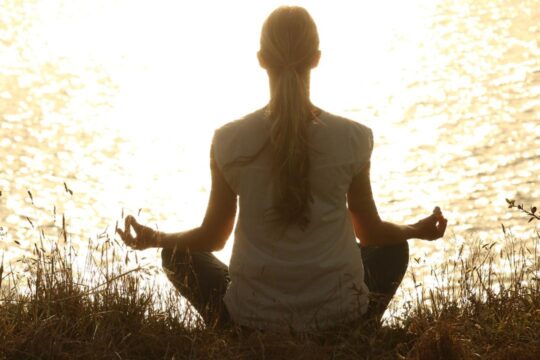- You have no items in your shopping cart
- Continue Shopping

The birds began their morning symphony at dawn, just as they have every day since I moved to this peaceful village in Andalusia. Their gentle songs have become like a sacred ritual, welcoming me to another day of presence as I settle into my meditation corner with my steaming cup of mint tea.
I was arranging my favorite Moroccan cushions when a memory surfaced — me, fifteen years ago, frantically googling “how to meditate” at 2 AM in my cramped Paris apartment.
My mind was racing, my heart pounding from another sleepless night of corporate anxiety. I thought meditation was just another productivity hack I needed to master.
How beautifully wrong I was.
If you’re feeling that same restless searching energy I once knew so well, if you’ve heard about mindfulness and meditation but aren’t sure where to begin, let me share what my heart has come to understand through years of gentle practice.
This isn’t about perfection or achieving some mystical state. It’s about coming home to yourself, one breath at a time.
What I Wish I’d Known About Mindfulness Back Then
Sitting here now on my terrace, watching the olive trees sway in the morning breeze, I can see how much my understanding has deepened since those early searching days.
Mindfulness isn’t complicated — it’s the gentle art of being fully present with whatever is happening right now, without judgment or the need to change anything.
I used to think I was “bad” at meditation because my mind wandered constantly. What a gift it was to discover that noticing when your mind wanders is mindfulness. That moment of awareness — “Oh, I was thinking about my grocery list” — that’s the magic happening right there.
Through my fifteen years of walking this peaceful path, now in the land of slow living, I’ve learned that mindfulness is less about sitting perfectly still and more about cultivating a loving awareness that you can carry into washing dishes, walking through your neighborhood, or having difficult conversations.
The Beautiful Science Behind Our Practice
What fills my heart with wonder is how modern science has begun to validate what ancient wisdom traditions have known for centuries. Psychologists have found that mindfulness meditation changes our brain and biology in positive ways, improving both mental and physical health in remarkable ways.
I recently read about research showing that just eight weeks of regular meditation practice can increase gray matter in areas of the brain associated with learning, memory, and emotional regulation.
Other studies have found that mindfulness can lower cortisol levels, reduce inflammation, and even strengthen our immune system.
But you know what moves me most about this research?
It’s not just proving that meditation works — it’s showing us that our brains are beautifully plastic, always capable of healing and growth. No matter how long you’ve been struggling with anxiety, depression, or feeling disconnected from yourself, your brain can change. Your heart can find peace.
This gives me such hope for every person who feels like they’re “too far gone” or “too anxious” to meditate. Your willingness to begin is enough.
My Journey from Chaos to Calm
Let me paint you a picture of where I was before I discovered this practice.
I was living in a constant state of mental chatter — analyzing past conversations, worrying about future deadlines, never quite present in my own life. I’d eat lunch while checking emails, talk to friends while scrolling social media, go to bed with my mind still spinning from the day.
The morning everything shifted, I found myself in Golden Gate Park at dawn, having barely slept again. I wasn’t trying to meditate — I was just sitting on a bench, feeling defeated and overwhelmed. But as I watched the sun rise through the morning fog, something extraordinary happened.
For just a moment, the mental chatter stopped.
In that silence, I felt something I’d been searching for my entire adult life — a deep, unshakeable peace that didn’t depend on having everything figured out or under control. It was already there, waiting patiently beneath all the noise.
That moment changed the entire trajectory of my life.
What Meditation Actually Looks Like (Spoiler: It’s Simpler Than You Think)
One of the most beautiful misconceptions I hear is that meditation requires sitting in lotus position for hours, chanting in Sanskrit, or achieving some blissful state of empty mind.
My Spanish neighbor María, who waters her geraniums every morning at exactly 7 AM, practices a form of meditation without ever calling it that. She’s fully present with her plants, her watering can, the morning light. This is mindfulness in action.

Meditation is simply the practice of returning your attention to the present moment, again and again, with kindness. It’s like training a puppy — you don’t get angry when the puppy wanders off; you gently guide it back with love.
In my early days, I thought the goal was to stop thinking entirely.
What liberation it was to learn that thoughts during meditation are like clouds passing through the sky of your awareness. You don’t need to push them away or judge them. You simply notice them and return to your chosen anchor — your breath, a mantra, or the sensations in your body.
The real magic happens not in achieving some perfect meditative state, but in that gentle moment of returning. Each time you notice your mind has wandered and bring it back, you’re strengthening your capacity for presence in all areas of life.
Simple Mindfulness Meditation Exercises to Begin Today
Let me share some gentle practices that have become like old friends on my journey. Choose the one that feels most welcoming to your heart today.
The Sacred Breath Practice
Find a comfortable position — sitting in a chair, on a cushion, or even lying down if that serves you better. There’s no wrong way to begin.
Close your eyes or soften your gaze toward the floor. Take three natural breaths, not trying to change anything, just noticing.
Now, begin to follow your breath as it flows in and out. You might notice the coolness as air enters your nostrils, the gentle expansion of your chest, the warm exhale as breath leaves your body.
When your mind wanders (and it will — this is completely natural), simply notice where it went with curiosity rather than judgment. “Ah, I was thinking about dinner.” Then gently return your attention to your breath.
Start with just five minutes. This isn’t about perfection; it’s about showing up with kindness for yourself.
The Loving Awareness Body Scan
Lie down comfortably and close your eyes. Begin by taking a few deep, nourishing breaths.
Starting with the top of your head, slowly move your attention through each part of your body. Notice any sensations — warmth, coolness, tension, relaxation — without trying to change anything. Simply observe with gentle curiosity.
Move from your head to your forehead, around your eyes, down to your jaw. Notice if you’re holding tension anywhere and breathe softness into those areas.
Continue down through your neck, shoulders, arms, chest, belly, hips, legs, all the way to your toes. This practice helps you reconnect with your body and develop a more intimate relationship with the present moment.
Mindful Morning Coffee (or Tea)
Tomorrow morning, try this simple practice that transforms an ordinary moment into a meditation.
When you’re preparing your morning beverage, do only that. Notice the sound of water boiling, the aroma of coffee or tea, the warmth of the cup in your hands.

Take your first sip slowly, really tasting it. Feel the warmth spreading through your body. Notice the steam rising from your cup.
This is mindfulness — bringing full attention to simple, everyday moments and discovering the extraordinary within the ordinary.
The Three-Breath Reset
This is my favorite practice for busy days when sitting meditation feels impossible. You can do this anywhere — at your desk, in your car, while waiting in line.
Take three conscious breaths:
First breath: Notice where you are and what you’re feeling without judgment.
Second breath: Soften any tension in your body, especially around your jaw, shoulders, and belly.
Third breath: Set an intention for how you want to move forward — with patience, kindness, or presence.
These three breaths can shift your entire nervous system and bring you back to center.
Creating Your Sacred Space (Even in a Tiny Apartment)
You don’t need a mansion or a perfect meditation room to begin. In my Paris days, my “sacred space” was a corner of my bedroom with a single cushion and a small plant. What matters isn’t the size or beauty of the space — it’s the intention you bring to it.
Choose a spot where you won’t be interrupted, even if it’s just a corner of your living room. Add something that feels peaceful to you — a candle, a photo from nature, a small plant, or simply a soft blanket.
The most important element of any meditation space is consistency. When you practice in the same spot regularly, that area begins to hold the energy of your practice. Even seeing your meditation corner can help shift your nervous system toward calm.
Here in Spain, my meditation corner faces east toward the olive groves. But I’ve practiced in airport terminals, hotel rooms, and hospital waiting rooms. Peace isn’t found in the perfect environment — it’s cultivated within yourself and then carried wherever you go.
Gentle Guidance for Common Challenges
Let me address some of the concerns I hear most often from beautiful souls beginning this journey:
“My mind is too busy to meditate.”
Oh, sweet friend, this is like saying you’re too dirty to take a shower. A busy mind is exactly why meditation is so beneficial. You’re not trying to stop thoughts — you’re learning to change your relationship with them.
“I don’t have time.”
I understand this feeling deeply. But consider this: meditation doesn’t take time from your day; it gives you more presence for everything you do. Even five minutes of mindful breathing can create more space and clarity than an hour of rushing through tasks on autopilot.
“I keep falling asleep.”
This often happens when we’re exhausted or holding a lot of tension. Honor what your body needs. If you fall asleep during meditation, perhaps that’s exactly what you needed in that moment. Try practicing with your eyes slightly open or in a more upright position.
“I don’t feel peaceful right away.”
Meditation isn’t about feeling immediately blissful — it’s about developing awareness. Sometimes what we become aware of first is how much stress we’ve been carrying. This awareness itself is the beginning of healing.
The Ripple Effects: How Mindfulness Changes Everything
What amazes me most about this practice is how it seeps into every aspect of life like morning light filling a room. When I first started meditating, I thought it was just about those twenty minutes on my cushion. I had no idea it would transform how I communicate with others, how I handle stress, how I experience joy, and how I move through the world.
Mindfulness taught me to pause before reacting in difficult conversations. It helped me taste my food more fully, appreciate sunsets more deeply, and sleep more peacefully. It didn’t eliminate challenges from my life, but it gave me a different way of meeting them — with presence instead of panic, curiosity instead of judgment.
I’ve watched countless souls in our ZenLines community discover these same gifts. The mother who learned to stay calm during her toddler’s tantrums. The business owner who found creativity flowing when he stopped trying to force solutions. The grandmother who discovered that her “senior moments” became opportunities for gentle self-compassion rather than harsh self-criticism.
These aren’t dramatic transformations that happen overnight. They’re subtle shifts that accumulate over time, like water slowly carving a riverbed. One day you realize you responded to a stressful situation with more ease than before. Another day you notice you’re naturally more grateful. These are the quiet miracles of regular practice.
Walking the Path Together
The path of mindfulness isn’t meant to be walked alone. In ancient times, spiritual seekers gathered in communities, supporting each other’s growth and celebrating each other’s insights. This beautiful tradition continues today in meditation groups, online communities, and spaces like our ZenLines family, welcoming hearts from every background and belief system.
I encourage you to find others who share this intention to live more mindfully. Whether it’s a local meditation group, an online community, or simply one friend who’s also interested in exploring presence, having companions on the journey makes it richer and more sustainable.
Share your experiences, your challenges, your small victories.
When someone tells you they’re “bad at meditation” because their mind wandered, you can smile and remind them that noticing the wandering is actually perfect mindfulness in action.
Honoring Your Unique Path
As you begin or deepen your mindfulness journey, remember that there’s no single “right way” to practice. Some people thrive with structured sitting meditation. Others find their deepest presence while walking in nature, creating art, or practicing yoga.
I’ve learned that the best meditation practice is the one you’ll actually do consistently. If sitting still feels torturous, try walking meditation. If silence feels overwhelming, experiment with guided meditations or gentle music. If morning practice doesn’t work with your schedule, find another time that does.
The ancient Zen masters understood that awakening has many faces. Your path might look different from mine, and that’s not just okay — it’s perfect. Trust your inner wisdom to guide you toward the practices that serve your unique nervous system, lifestyle, and temperament.
What matters most is showing up with an open heart and gentle curiosity. Your willingness to begin is already a profound act of self-love.
Through my journey since 2010 and the beautiful community at ZenLines, I’ve witnessed countless souls discover the inner peace that was always there, waiting patiently to be recognized. You carry this same treasure within you. The path unfolds one mindful breath, one present moment, one act of self-compassion at a time.
Your inner sanctuary of peace is calling you home. Trust the gentle voice within, honor your sacred journey, and remember — in this very moment, you are exactly where you need to be.
The birds will sing again tomorrow morning, and I’ll return to my meditation corner with my warm cup of mint tea, just as I hope you’ll return to yours. Not because we have to, but because we’ve tasted the sweetness of presence and know it’s worth cultivating.
May you walk in peace. 🕊️


